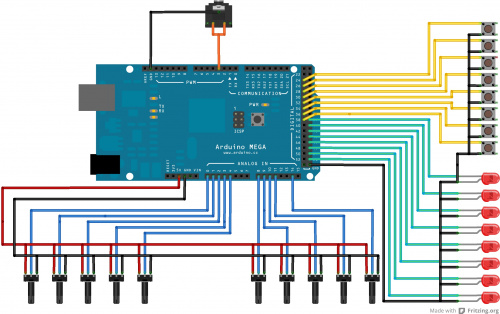
Code:
int tempo = 100000;
int pattern = 0;
int counter = 0;
int a1 = 0; int a2 = 0; int a3 = 0; int a4 = 0; int a5 = 0;
int b1 = 0; int b2 = 0; int b3 = 0; int b4 = 0; int b5 = 0;
int c1 = 0; int c2 = 0; int c3 = 0; int c4 = 0; int c5 = 0;
int d1 = 0; int d2 = 0; int d3 = 0; int d4 = 0; int d5 = 0;
int e1 = 0; int e2 = 0; int e3 = 0; int e4 = 0; int e5 = 0;
int f1 = 0; int f2 = 0; int f3 = 0; int f4 = 0; int f5 = 0;
int g1 = 0; int g2 = 0; int g3 = 0; int g4 = 0; int g5 = 0;
int h1 = 0; int h2 = 0; int h3 = 0; int h4 = 0; int h5 = 0;
int live_sync_phase = 0;
int live_grain_phase = 0;
int live_grain_decay = 0;
int live_grain2_phase = 0;
int live_grain2_decay = 0;
pinMode(39, OUTPUT); digitalWrite(39, LOW);
pinMode(41, OUTPUT); digitalWrite(41, LOW);
pinMode(43, OUTPUT); digitalWrite(43, LOW);
pinMode(45, OUTPUT); digitalWrite(45, LOW);
pinMode(47, OUTPUT); digitalWrite(47, LOW);
pinMode(49, OUTPUT); digitalWrite(49, LOW);
pinMode(51, OUTPUT); digitalWrite(51, LOW);
pinMode(53, OUTPUT); digitalWrite(53, LOW);
pinMode(24, INPUT); digitalWrite(24, HIGH);
pinMode(26, INPUT); digitalWrite(26, HIGH);
pinMode(28, INPUT); digitalWrite(28, HIGH);
pinMode(30, INPUT); digitalWrite(30, HIGH);
pinMode(32, INPUT); digitalWrite(32, HIGH);
pinMode(34, INPUT); digitalWrite(34, HIGH);
pinMode(36, INPUT); digitalWrite(36, HIGH);
pinMode(38, INPUT); digitalWrite(38, HIGH);
void loop() {
counter++;
if(counter>tempo){
counter=0; //Reset the counter variable
if(pattern==8){pattern=0;} //Make sure we're not about to go to imaginary step 9.
pattern++; //Let all of the following code know that we're setting up for the next step
//Turn off all of the step indicator lights in preparation for lighting the correct one.
digitalWrite(39, LOW);digitalWrite(41, LOW);digitalWrite(43, LOW);digitalWrite(45, LOW);
digitalWrite(47, LOW);digitalWrite(49, LOW);digitalWrite(51, LOW);digitalWrite(53, LOW);
live_sync_phase = map(analogRead(14),0,1023,-500,500);
live_grain_phase = map(analogRead(10),0,1023,-200,200);
live_grain_decay = map(analogRead(9),0,1023,-20,20);
live_grain2_phase = map(analogRead(8),0,1023,-200,200);
live_grain2_decay = map(analogRead(11),0,1023,-50,50);
tempo = map(analogRead(15),0,1023,1000,32000);
switch(pattern){
case 1:
syncPhaseInc = a1 + live_sync_phase; grainPhaseInc = a2 + live_grain_phase; grainDecay = a3 + live_grain_decay; grain2PhaseInc = a4 + live_grain2_phase; grain2Decay = a5 + live_grain2_decay; digitalWrite(53, HIGH); break;
case 2:
syncPhaseInc = b1 + live_sync_phase; grainPhaseInc = b2 + live_grain_phase; grainDecay = b3 + live_grain_decay; grain2PhaseInc = b4 + live_grain2_phase; grain2Decay = b5 + live_grain2_decay; digitalWrite(51, HIGH); break;
case 3:
syncPhaseInc = c1 + live_sync_phase; grainPhaseInc = c2 + live_grain_phase; grainDecay = c3 + live_grain_decay; grain2PhaseInc = c4 + live_grain2_phase; grain2Decay = c5 + live_grain2_decay; digitalWrite(49, HIGH); break;
case 4:
syncPhaseInc = d1 + live_sync_phase; grainPhaseInc = d2 + live_grain_phase; grainDecay = d3 + live_grain_decay; grain2PhaseInc = d4 + live_grain2_phase; grain2Decay = d5 + live_grain2_decay; digitalWrite(47, HIGH); break;
case 5:
syncPhaseInc = e1 + live_sync_phase; grainPhaseInc = e2 + live_grain_phase; grainDecay = e3 + live_grain_decay; grain2PhaseInc = e4 + live_grain2_phase; grain2Decay = e5 + live_grain2_decay; digitalWrite(45, HIGH); break;
case 6:
syncPhaseInc = f1 + live_sync_phase; grainPhaseInc = f2 + live_grain_phase; grainDecay = f3 + live_grain_decay; grain2PhaseInc = f4 + live_grain2_phase; grain2Decay = f5 + live_grain2_decay; digitalWrite(43, HIGH); break;
case 7:
syncPhaseInc = g1 + live_sync_phase; grainPhaseInc = g2 + live_grain_phase; grainDecay = g3 + live_grain_decay; grain2PhaseInc = g4 + live_grain2_phase; grain2Decay = g5 + live_grain2_decay; digitalWrite(41, HIGH); break;
case 8:
syncPhaseInc = h1 + live_sync_phase; grainPhaseInc = h2 + live_grain_phase; grainDecay = h3 + live_grain_decay; grain2PhaseInc = h4 + live_grain2_phase; grain2Decay = h5 + live_grain2_decay; digitalWrite(39, HIGH); break;
}
if(digitalRead(24)==LOW){changeStep(1);}
if(digitalRead(26)==LOW){changeStep(2);}
if(digitalRead(28)==LOW){changeStep(3);}
if(digitalRead(30)==LOW){changeStep(4);}
if(digitalRead(32)==LOW){changeStep(5);}
if(digitalRead(34)==LOW){changeStep(6);}
if(digitalRead(38)==LOW){changeStep(7);}
if(digitalRead(36)==LOW){changeStep(8);}
}}
void changeStep(int step_num){
digitalWrite(39, LOW);digitalWrite(41, LOW);digitalWrite(43, LOW);digitalWrite(45, LOW);
digitalWrite(47, LOW);digitalWrite(49, LOW);digitalWrite(51, LOW);digitalWrite(53, LOW);
switch(step_num){
case 1:
digitalWrite(53, HIGH); break;
case 2:
digitalWrite(51, HIGH); break;
case 3:
digitalWrite(49, HIGH); break;
case 4:
digitalWrite(47, HIGH); break;
case 5:
digitalWrite(45, HIGH); break;
case 6:
digitalWrite(43, HIGH); break;
case 7:
digitalWrite(41, HIGH); break;
case 8:
digitalWrite(39, HIGH); break;
}
while(1){
counter++;
if(counter>tempo){
counter=0;
syncPhaseInc = mapPentatonic(analogRead(SYNC_CONTROL));
grainPhaseInc = mapPhaseInc(analogRead(GRAIN_FREQ_CONTROL)) / 2;
grainDecay = analogRead(GRAIN_DECAY_CONTROL) / 8;
grain2PhaseInc = mapPhaseInc(analogRead(GRAIN2_FREQ_CONTROL)) / 2;
grain2Decay = analogRead(GRAIN2_DECAY_CONTROL) / 4;
if(digitalRead(24)==LOW && step_num==1){
a1 = syncPhaseInc; a2 = grainPhaseInc; a3 = grainDecay; a4 = grain2PhaseInc; a5 = grain2Decay;
return;}
else if(digitalRead(24)==LOW && step_num==2){
b1 = syncPhaseInc; b2 = grainPhaseInc; b3 = grainDecay; b4 = grain2PhaseInc; b5 = grain2Decay;
return;}
else if(digitalRead(24)==LOW && step_num==3){
c1 = syncPhaseInc; c2 = grainPhaseInc; c3 = grainDecay; c4 = grain2PhaseInc; c5 = grain2Decay;
return;}
else if(digitalRead(24)==LOW && step_num==4){
d1 = syncPhaseInc; d2 = grainPhaseInc; d3 = grainDecay; d4 = grain2PhaseInc; d5 = grain2Decay;
return;}
else if(digitalRead(24)==LOW && step_num==5){
e1 = syncPhaseInc; e2 = grainPhaseInc; e3 = grainDecay; e4 = grain2PhaseInc; e5 = grain2Decay;
return;}
else if(digitalRead(24)==LOW && step_num==6){
f1 = syncPhaseInc; f2 = grainPhaseInc; f3 = grainDecay; f4 = grain2PhaseInc; f5 = grain2Decay;
return;}
else if(digitalRead(24)==LOW && step_num==7){
g1 = syncPhaseInc; g2 = grainPhaseInc; g3 = grainDecay; g4 = grain2PhaseInc; g5 = grain2Decay;
return;}
else if(digitalRead(24)==LOW && step_num==8){
h1 = syncPhaseInc; h2 = grainPhaseInc; h3 = grainDecay; h4 = grain2PhaseInc; h5 = grain2Decay;
return;}
}
}
}





